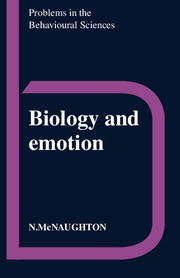Book contents
- Frontmatter
- Contents
- Preface
- Acknowledgements
- 1 Emotion since Darwin
- 2 Releasers and state-dependent reflexes
- 3 Purpose and emotion
- 4 Expression: a window on the emotions?
- 5 Are physiological changes epiphenomena of emotion?
- 6 Somatic influences on the emotions
- 7 Optimal foraging and the partial reinforcement effect: a model for the teleonomy of feelings?
- 8 Do emotions mature or differentiate?
- 9 Cognition, learning and emotion
- 10 Interaction of the components of emotion
- 11 Of mice and men
- 12 Biology and emotion: some conclusions
- Glossary
- Notes
- References
- Index
12 - Biology and emotion: some conclusions
Published online by Cambridge University Press: 05 August 2012
- Frontmatter
- Contents
- Preface
- Acknowledgements
- 1 Emotion since Darwin
- 2 Releasers and state-dependent reflexes
- 3 Purpose and emotion
- 4 Expression: a window on the emotions?
- 5 Are physiological changes epiphenomena of emotion?
- 6 Somatic influences on the emotions
- 7 Optimal foraging and the partial reinforcement effect: a model for the teleonomy of feelings?
- 8 Do emotions mature or differentiate?
- 9 Cognition, learning and emotion
- 10 Interaction of the components of emotion
- 11 Of mice and men
- 12 Biology and emotion: some conclusions
- Glossary
- Notes
- References
- Index
Summary
Another error is an impatience of doubt, and haste to assert without due and mature suspension of doubt…
If a man will begin with certainties, he shall end in doubts; but if he will be content to begin with doubts he shall end in certainties.
Francis Bacon. Advancement of Learning. I.v.8What is an emotion?
Each of the previous chapters has provided us with reasons for approaching emotions from a teleonomic perspective and for analysing the control of emotions by biological methods. As I stated at the beginning of this book, I think the data show that biology provides a useful basis for the study of emotion. It enables us to ask the right sort of questions about emotion. I also stated at the outset that the book would not provide a new theory of the emotions. There are two reasons, in this case, why asking the right sort of question does not lead immediately to what could be thought of as the right sort of answer. First, a biological approach should be seen as providing only the foundation for the construction of theories of emotion. (The virtue of biology is that the foundation it provides is a stable one.) There are many aspects of emotion, particularly in humans, which require social/cultural analysis, in addition to biological analysis, for their elucidation.
- Type
- Chapter
- Information
- Biology and Emotion , pp. 169 - 191Publisher: Cambridge University PressPrint publication year: 1989

